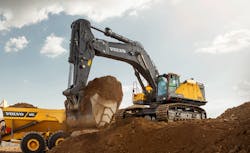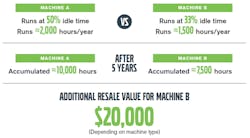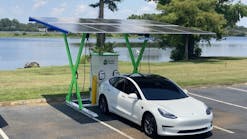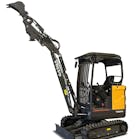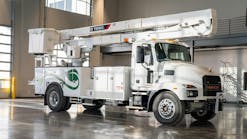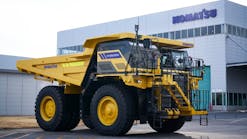As the population of machines equipped with factory-installed telematics systems has increased in recent years, equipment manufacturers have encouraged customers to use this powerful technology, often suggesting that tracking machine idling time might be a way to ease into using the data. In many instances, equipment managers who followed this advice have been quite taken aback by the high percentage of idling time in their fleets.
One manufacturer reports, for example, that data collected from customer machines indicate that, on average, a 36-ton excavator in North America runs about 1,000 hours per year, but is idling about 40 percent of that time, using about a gallon of fuel per hour at idle—for an annual total of some 400 gallons. That figure, multiplied through a sizeable fleet, can result in considerable expense. Burning fuel that accomplishes no work may not be the only downside of extended idling.
Leigh Dennis, CEM, manager, fleet services, for the North Carolina-based Sunrock Group, sees additional consequences.
“If you bill production departments internally for the hourly use of machines, idling is an unnecessary cost of epic proportion,” says Dennis. “Adding to this is lost or wasted warranty—so many new machines use up the hour-terms of their warranties just idling and never have the chance to fail under load. And if the maintenance system is based on hours of utilization, then the owner incurs unnecessary preventive-maintenance costs. Another cost often overlooked is the unnecessary maintenance and repair of the exhaust aftertreatment system on newer engines. Then there’s the effect on fuel economy of individual machines, as well as company-wide—total bulk fuel purchased, versus total hours of utilization.”
Craig McGinnis, manager, business solution group, Komatsu America, raises another issue.
“Perhaps the highest cost of extended idling is the hour-meter reading when the machine is traded for a new machine or sold privately or taken to auction,” he says. “Lower-hour machines command higher prices than high-hour machines of the same vintage. Residual value might be the most expensive consequence of idling time, and it’s one of those things that creeps up on you, and you don’t realize it until it’s too late to do anything about it. If owners find that their 7,000-hour machines are competing with machines that have 5,500 hours, they won’t get as much.”
How to decide when idling is acceptable
Drawing hard-and-fast lines on acceptable idling time, however, is not a settled issue.
The amount of idle time for a machine greatly depends on particular factors, including job site, application, and geography, says Joshua White, territory customer support manager, John Deere.
“In certain applications,” says White, “such as an excavator in a pipe-laying application, or a machine working in colder regions, it’s common to see high idle time. So, it’s tough to draw broad conclusions about an ‘average’ machine and what is good or bad idle time. It’s best for each contractor to determine what is acceptable to them based on the application.”
Matt Beinlich, director, Business Solutions Group, Komatsu America, concurs.
“Idling is inherently wasteful, not what an engine is designed to do,” he says. “But we realize that on all construction and mining sites, situations arise that require the machine to idle. So, it becomes a matter of the most practical operational choice, even though the operator knows that it will waste fuel. We just ask that customers consider it thoughtfully.”
John Bartz, director, product assurance and regulation, Volvo Construction Equipment, sums up what seems to be a consensus among most equipment manufacturers. “Some conditions mandate it [idling], but generally speaking, we encourage minimal idling.”
How much do machines idle?
As John Deere’s White said, it’s difficult to draw broad conclusions about an “average” machine and what is good or bad idle time. Some manufacturers have investigated idling time over a broad spectrum of machines, however, and have at least developed a few ballpark figures, which might give fleet managers a basis of comparison.
“I would say an average for a large construction fleet—about 450 machines—is 28 to 30 percent idle time, but this can vary widely based on application, weather, and industry segment,” says Jim Bretz, director, uptime and connected services, Region Americas, Volvo Construction Equipment. “Also, keep in mind that the 28-to-30-percent figure for idle time, versus work time, is averaged over a longer period of time (not just 24 hours).”
Komatsu used machine data to study idling, says Beinlich.
“Based on telematics data collected during a 12-month interval to rule out seasonal variations, and based on data from about 75,000 machines, the average idle time for Komatsu machines in North America was 38 percent,” he says. But that figure will vary substantially depending on where machines are located, the type of machines, the size of the machines. Large machines tend to idle less, because customers realize that the larger the machine, the more expensive to have it idle. And, that figure will vary substantially from month to month, with winter months having the highest rates.
“When you show customers those overall conclusions,” says Beinlich, “their first reaction is one of surprise, and typically their comments are that ‘they’re nowhere near that number.’ But when you show them their own data, about half the time they’re below that number, but half the time they’re above it. We find that most customers who are really trying to manage idling shoot for about 20 percent, saying that figure realistically balances their operational needs, but allows the machine to be shut down in the right circumstance to keep from wasting machine hours.”
Does idling harm engines?
Fleet managers concerned about the possible consequences of extended idling intervals ask some good questions: Does engine temperature drop below an optimum level, resulting in certain components, such as pistons and rings, not expanding to full operating size and shape to seal mating surfaces, causing blow-by and oil consumption? Is fuel incompletely burned during idling, washing oil off cylinder walls, causing wear and diluting the oil in the sump? Do oil flow and oil pressure diminish and jeopardize turbocharger bearings or other rotating surfaces? Does carbon build up on piston rings and at low engine temperatures?
To some extent, the answers to those questions might depend on the age of the engine.
“In older trucks and machines, excessive idling can kill cylinder packs by scarring rings and cylinder walls, resulting in loss of compression into the crankcase and possible fuel dilution of engine oil,” says Sunrock’s Dennis.
For newer engines, physical damage caused by excessive idling—at least to the engine’s major internal working components—seems to be less of a risk. Komatsu’s McGinnis says that, generally speaking, electronic control systems on today’s machines are designed to mitigate the potential downside of extended idling. He does, however, cite another idling-related issue that can have an effect on newer engines.
“What does remain important for avoiding potential engine damage is proper warm-up before working the machine, and a five-minute cool-down for machines that have been working hard, because the components most at risk are the turbo bearings,” says McGinnis. “The bearings are cooled either by the engine’s coolant or lubricating oil, and when the engine shuts down, the pumps shut down, and the bearings are no longer being cooled and become extremely hot.”
John Deere’s White also says that idling (even idling overnight or over a weekend, likely because of cold conditions) should not affect a newer engine’s oil pressure and oil flow, nor should it result in fouling of pistons rings. Oil pressure and oil flow are key parts of the design of bearings and other contact surfaces, which rely on oil for lubrication, says White. As long as machine owners adhere to the type and viscosity of oil recommended in the manufacturer’s manual, he says, bearing systems will be protected—even during extended idle operation. Oil coking in the ring pack is basically a non-issue for extended-idle operation, he says, because temperatures in the ring pack are low during idle conditions.
“Perhaps the more important considerations [when a machine idles for long intervals],” says White, “are freezing the crankcase system or an ETM [electronic throttle management] request from the ECU—but it’s difficult to determine the exact level of probability [of these events] due to the variety in application and environmental conditions.”
Newer engines are seemingly less at risk for internal damage from extended idling because of design advancements, says Sunrock’s Dennis.
“Overall, it’s important to point out that high-pressure/common-rail [HPCR] fuel systems and computer-controlled, multishot injection systems changed everything,” says Dennis. “These advancements seem to mitigate some of the consequences of extended idling that might affect older engines.
“For example, right up through Tier-2, yes, you could still douse the cylinder walls with gushers of diesel fuel from electronic injectors in an engine that could not achieve operating temperature due to excessive idling,” Dennis says. “The injectors were like garden hoses, and the control systems were numb and dumb, in comparison with today’s HPCR systems. Machine owners paid a heavy price in fuel, unnecessary maintenance, and eventually, internal engine damage that could be seen in excess black exhaust, oil analysis, and manometer [crankcase-blowby] tests.”
Tier 4-F and EU5 applied technologies have injectors controlled to fire several times during a single 4-cycle sequence, at incredibly high pressures, through ports measured in microns—but all at much lower fluid volumes, says Dennis. The resulting combustion efficiency, he says, causes these engines to burn hotter, even at idle, compared with older engines, and results in much greater fuel efficiency, both at idle and full load. In his experience, however, excessive idling takes its toll on newer engines primarily by more quickly fouling emissions-control components in the exhaust aftertreatment system with unburned particulates.
“Excessive idling allows unburned diesel particulates to coat or clog the emission-control-system components on newer engines,” says Dennis. “Many do not realize that in newer engines, it’s not just the DOC [diesel oxidation catalyst] or DPF [diesel particulate filter]—and in some instances, the SCR [selective catalytic reduction] system—that are affected. It also affects the efficiencies and service lives of other components that come before all of that. These components are legally considered part of emission control.”
Those other components, says Dennis, include the exhaust-gas-recirculation valve, which has small venturis that can become clogged with soot, and the linkage and vanes in a variable-geometry turbocharger.
In addition, says Dennis, the fuel injector (used in the regeneration process), located just downstream of the turbocharger, can be affected by these conditions. The ECM (electronic control module) will direct it to fire and heat up the DOC and DPF much more often than normal, he says. The ECM must adapt to the reduced efficiencies of all the various emission-control components and respond as programmed, says Dennis, but it might not show active fault codes for all of those items that are just partially clogged and working at reduced capacity.
“And after all that,” says Dennis, “just replacing the part associated with a fault code will not get you back to full operating efficiency by any means, even if you get your idling under control. It’s just my opinion, but to counteract all of this, I’d suggest researching and purchasing exhaust aftertreatment/HPCR fuel-system/engine-crankcase cleaning systems that, when incorporated into a PM program, significantly reduce downtime and repair by keeping all of these system components clean internally.”
The equipment manufacturers responding to CE’s inquiries about idling were unanimous in saying that they recommend to customers concerned about excessive idling to use the machine’s built-in technology as part of a program to control idling in appropriate operating situations. The telematics system, available on most machines today, is an accurate method for determining the extent of idle time versus working time. Once determined, the auto-shutdown system could be used to control idling in appropriate situations. These systems typically can be adjusted in small time increments from 5 to 60 minutes.
“[Auto-shutdown] should be set and enabled on virtually every project,” says John Deere’s White. “The time increment will change, of course, based on application.”
